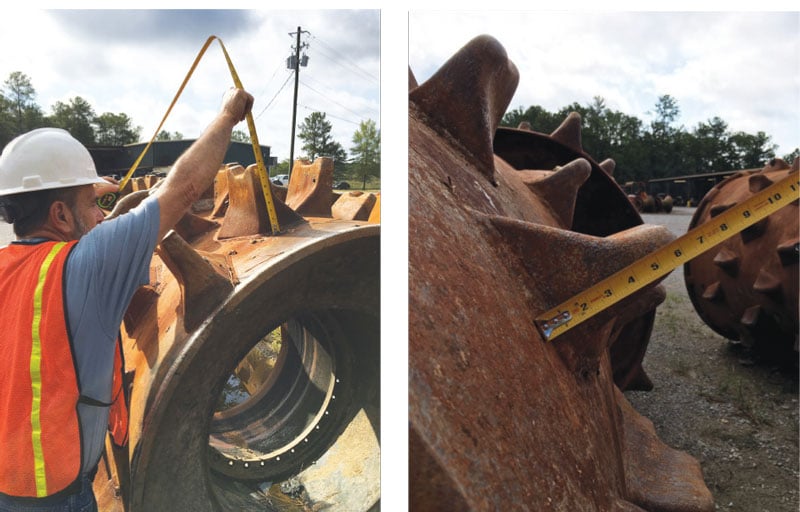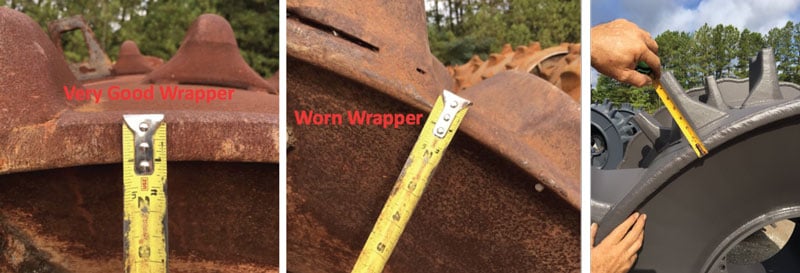By performing regular wheel inspections and rotating the wheels as needed, you will ensure even wear and tear and the longest use before replacement.
By David E. Sonnentag
One of the most expensive replacement items on landfill compactors are the wheels. Average wheel life is approximately four years so maintaining your wheels and maximizing their life, compaction (density) and airspace (a landfills capacity) is very important to landfill owners and operators.
Wheel Rotation: Extend Cleat and Wheel Life
The best way to increase cleat and wheel life is to rotate wheels at the proper time. Rotate them front to back with rights on rights and lefts on lefts on most landfill compactors. The recommendation for wheel rotation is every 2,000 to 2,500 hours or once per year. This may vary from landfill to landfill based on material type. For Example, C&D (construction and demolition) is very abrasive when compared to household trash. Cleats are considered at “end of life” at approximately 4 1⁄2″ to 5″ tall and replacement should be done at this time. If you do not, the landfill starts to lose compaction and gives up valuable airspace.
Determining Average Cleat Height/Rotation
In order to determine cleat height and rotation, measure the two front wheels to get their average cleat height, then measure the two rear wheels to get their average cleat height. Start in the second to third row in from the outer edge. When the average cleat height differs by a 1⁄4″ to 1⁄2″ between front and rear wheels, rotate wheels from front to back. The rear wheels/cleats usually wear much quicker than the front, so it is important to pay particular attention to the rear wheels. At times, it is extremely obvious the wheels need to be rotated because the rear cleats can be ½” to ¾” shorter than the front.


In Field – Cleat Height Measurement
Set a tape measure on a clean area of the wrapper/drum behind the cleat and look over the top portion of the cleat. Take photos of all four wheels and record measurements.
In Field – Wrapper/Drum Measurements
When determining wrapper/drum conditions, measure the outer edge of the rear wheel, look for any remaining hard-facing on the edges or at least 3⁄4″ remaining wrapper thickness on all four wheels. Again, the rear wheel bodies usually wear quicker than the front. If the edges are good, åçbars. If wrapper thickness is at a minimum of 3⁄4″ thick, it usually is okay to reuse and do a “Recleat”, which is cutting off the old, worn cleats from the wrappers/drums and welding new cleats on. It is much less expensive than doing a complete “Rebuild”, which is cutting off the old, worn wrappers/drums and cleats and replacing with brand new 1″ thick wrappers/drums and adding new cleats. In addition, if wrapper thickness is less than 3⁄4″ thick and shows extreme wear, it requires a rebuild. Set a tape measure on the wrapper/drum edge. Take photos of two front wheel wrappers and two rear wheel wrappers.
Not Rotating Wheels
To ensure even wear on your cleats and wrappers, rotate every 2,000 hours. When the wheels are not rotated, it results in premature replacement due to uneven wear and tear on the cleat height and the thickness of the wrappers. This leads to unneeded expense, lost compaction and wasted airspace.

Other Tips for Extending Cleat and Wheel Life
Hard-Face the Cleats
Most cleats in the industry are “cast” of steel with high wear-resistant materials to help withstand the harsh landfill environment and maximize their life; however, every cleat eventually wears out. For example, by adding “hard-facing”, chrome-carbide to the tips of the cleats, it will extend the life of the cleats. Every cleat Terra installs on its wheels is hard-faced. In some cases, customers add two passes of hard-facing to the cleat tips to extend the life even longer; especially in harsh environments like C&D.

Hard-Face the Wheel Wrappers/Drums
Standard hard-facing in the industry is welding one-pass of hard-facing material on the wheel wrappers/drums horizontal edge on both sides of each wheel. Much like additional hard-facing on cleat tips, adding additional hard-facing material to the wrappers/drums “vertical” edge, as well as the horizontal edge, will extend the life of the wheels.

By following these simple guidelines and including them in your maintenance practices, it will extend the life of your cleats and wheels, save you money, help maximize compaction and prolong your landfill’s life by maximizing its airspace. | WA
David E. Sonnentag is Co-Owner of Terra Compactor Wheel Corp. (Sheboygan, WI), a leading manufacturer of landfill compaction wheels, soil wheels, landfill tipper wheels, transport wheels, wire guards, belly pans and other machine guarding parts. For more information, call (844) 513-2781 or visit www.terracompactorwheel.com.
